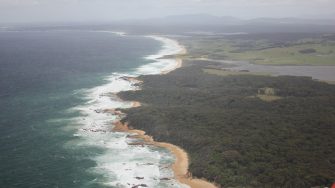
Date: Tuesday, October 27, 2015
Project: Eastern Australian Waterbird Survey
Observer - Richard Kingsford
We headed south from Sydney to do the two most southerly survey bands over this week. Band 2 runs from around Bermagui on the NSW south coast, through to north of Kingston on the coast of South Australia, south of Adelaide. And Band 1 is south of Melbourne, from Seaspray on the east coast through to Port Fairy in southwestern Victoria. Conditions were cool but overcast and not pleasant out of Bankstown airport in Sydney. Our pilot decided to fly on instruments until we had good visibility, which was soon afterwards.
On our way south, we pick up the most eastern wetlands on Band 3: two dams around Sydney and Lake Illawarra, near Wollongong. The dams are deep and, as usual, no waterbirds. They are poor wetlands for most plants and animals; next time you hear dams are good for wildlife, it’s not true. Lake Illawarra is a typical estuarine lake – lots of silver gulls, black swans, the odd chestnut teal and different cormorant species. Nothing particularly exciting.
Photo – Lake Illawarra surrounded by the suburbs of Wollongong.
The sun broke through the clouds about an hour and a half into our flight down the south coast. This is a beautiful part of Australia. The jagged coast with its little beaches, rocks and promontories is very picturesque. Here the Great Dividing Range comes almost down to the water in places. There are patches of littoral rainforest in the gullies of the hills, with their palms and tree ferns. Whale watching , a nice past time when flying between survey bands, was not profitable today, mainly because the wind was blowing hard, whipping up white caps so we couldn’t see any breaching.
The eastern edge of Band 2 is typical of this part of the coast with inlets and the coastal lake, Lake Wallaga. These lakes often have large numbers of swans but not today. These estuaries and inlets usually have a relatively small compliment of cormorants and herons but there seemed to be even fewer birds than normal which was surprising given how dry the inland is.
Photo – The south coast with Wallaga Lake in the background
From here, we flew down to Band 1, flying along 90 Mile Beach. It’s a joy and great privilege to get this wonderful bird’s eye view of this coastline. There is the odd person fishing but mainly it is just endless sand, interrupted by the odd Pacific Gull.
Photo – 90 mile beach, with our red plane in the foreground
Just south of Seaspray, our sight seeing stops and we need to get to work surveying. We go back and forth across the 30km wide survey band, starting with the most easterly lakes. Jack Smith Lake is one of my favourite when it has water because of its clouds of waterbirds, feeding in the shallows. Today it was dry – not unexpectedly, given the conditions. Small hides and nest boxes scattered across these lakes seem out of place with no birds to attract or shoot during the duck season. Then on down to northern part of Corner Inlet where there are always lots of birds on this highly productive estuary where migratory shorebirds, ibis and herons feed on the shallow mud flats.
Video – Surveying the northern part of Corner Inlet on the east coast of Victoria in Gippsland
We bounce our way across the hills, picking up a few farm dams and reservoirs along the way. The dams often have a few Pacific black duck while the reservoirs usually have a few small flocks of comorants.
Video – Green fields with their dairy herds stretch across this part of Gippsland with small farm dams and a few large reservoirs.
Western Port Bay is full of swans, more than in previous years, probably many escaping the dry inland. This really isn’t wetland country or waterbird habitat. Phillip Island has a few promising lagoons. Rhyll Swamp is always worth looking forward to seeing because of the anticipation of ibis colonies – not today. No action in the swamp. We flew across the Moto GP race track, deserted of all the action from a couple of weeks ago. Cape Barren geese graze the pastures near the lagoons.
And on west, across the Otway Ranges where unproductive dams lie at the bottom of the deep gorges. No place for waterbirds. Out of there and then surveying a series of farm dams to survey. About a couple of decades ago, I remember Swan Marsh, a magnificent shallow wetland, guaranteed to have a few hundred waterbirds. Drains cut through the swamp have virtually destroyed it. The next survey wetland was Curdies Inlet, down the coast and just west of the 12 Apostles. This is great habitat for swans and there were hundreds as well as few ducks. West of here is usually dotted by small lagoons, each with their complement of a few Australian shelduck and chestnut teal. Only one or two had water; the rest were dry. I have seldom seen it this dry in the part of Victoria. The picture here is grim as in many parts of the country. We finish in Warrnambool.
